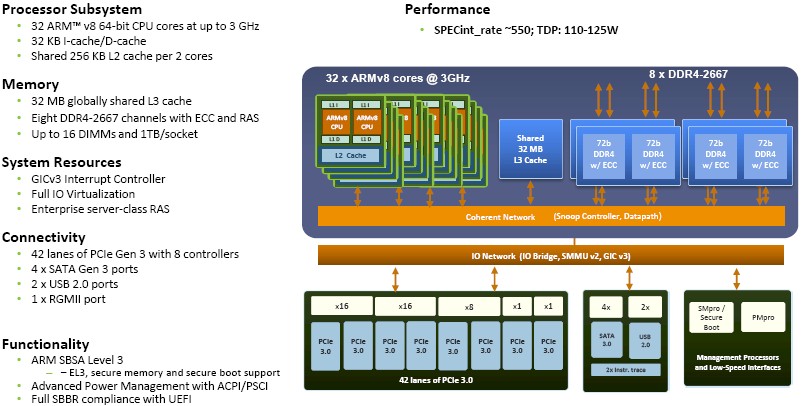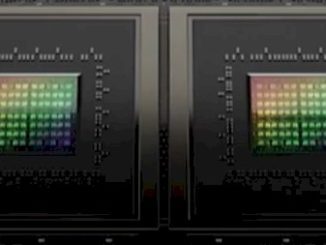
The lineup of ARM server chip makers has been a somewhat fluid one over the years.
There have been some that have come and gone (pioneer Calxeda was among the first to the party but folded in 2013 after running out of money), some that apparently have looked at the battlefield and chose not to fight (Samsung and Broadcom, after its $37 billion merger with Avago), and others that have made the move into the space only to pull back a bit (AMD a year ago released its ARM-based Opteron A1100 systems-on-a-chip, or SOCs but has since shifted most of its focus on its X86 Zen architecture).
That said, there are other vendors that are continuing their efforts to push the low-power ARM architecture into the datacenter, with Cavium and its ThunderX SoCs and Qualcomm with its upcoming Centriq family of ARM server chips among them.
Applied Micro certainly can be added to the latter list. Over the past several years, it has rolled out two generations of its X-Gene ARM-based SoCs, and this month began sampling its upcoming 32-core X-Gene 3 chips with a handful of select customers with the hope of pushing the product into cloud environments.
Officials are pointing to the performance and energy efficiency improvements in the new SoCs that they say will enable to better compete not only with products from other ARM server chip makers but also with Intel, the dominant player in the datacenter with well over 90 percent market share. At the same time, there are significant challenges ahead. As we’ve talked about here at The Next Platform, despite the idea of ARM-based servers being debated for almost a decade and the pent-up demand among end users for viable alternatives to Intel and its X86-based chips, there has not been widespread adoption of such systems. At the same time, other efforts are underway to offer options to Intel, including AMD and its push to build up its X86 offerings – as we talked about with the vendor’s recent unveiling of its impending “Naples” chips – and IBM through its OpenPower Foundation.
For Applied Micro, there also is the fact that it recently was bought by Macom Technology Solutions in a $770 million deal that was centered around Applied Micro’s datacenter connectivity offerings. The new owners intend to spin off Applied Micro’s compute business – which includes the X-Gene processors – within the first 100 days after the closing of the deal in late January. During a conference call at the end of January to discuss Macom’s quarterly earnings, CEO John Crouteau said that the company has “received unsolicited interest from numerous parties since we announced the definitive agreement, and we believe we’ll be able to find a good home for the Compute team within that 100-day window.”
Spinning off the Applied Micro compute business shouldn’t have much of an immediate impact on the unit’s plans, according to Kumar Sankaran, associate vice president of software and platform engineering for the compute business. The X-Gene 1 and X-Gene 2 SoCs are already in production and will continue to roll out without interruption, and development of X-Gene 3 is well underway. The only possible change in the roadmap will come after, Sankaran told The Next Platform. The game plan had been to roll out a 64-core X-Gene 3XL followed by the X-Gene 4. However, the company may combine the two into a single chip, a move that has more to do with the effort around shrinking the die rather than being spun off of Macom.
Sankaran and other Macom/Applied Micro officials are at the Open Compute Project US Summit this week in Silicon Valley to update potential customers and end users about the upcoming X-Gene 3 and to show off the SoCs through a demo featuring a compute platform powered by the chips. Sankaran expects that there will be some systems powered by the X-Gene 3 chips coming to market later this year, probably in the third and fourth quarters, but that the ramp will begin in earnest in the first quarter 2018 after the SoCs become generally available. In the meantime, company officials plan to work with the larger hyperscale cloud providers – whose ranks include the likes of Google, Amazon, Microsoft, Baidu, and Tencent – to show them what the new SoCs can do for them in terms of application performance, power efficiency, and throughput.
“We will be engaging the top five or top six hyperscale datacenter vendors throughout the world, number one in Asia and number two in the United States,” Sankaran said. Whether such engagements will loosen Intel’s grasp on cloud datacenters remains to be seen. Applied Micro officials have said the goal is to create ARM-based SoCs that offer similar or superior performance and energy efficiency as Intel’s Xeon processors, and Sankaran said the 16 nanometer X-Gene 3 “will look and feel exactly like an X86 processor” from the BIOS to the OS support. We have previously outlined the features in the X-Gene 3, and Sankaran said there are several key ones that will help the SoCs compete with Intel and separate them from those from other ARM server chip vendors.
Key among those are the 32 ARMv-8 cores that can ramp up to 3 GHz – and in some instances 3.3GHz – and the eight DDR4-2667 memory channels with ECC and RAS that support up to 16 DIMMs, up to 1 TB of memory and 42 PCI-Express 3.0 lanes with eight controllers, which he said surpasses what Intel offers in its Xeon chips in terms of memory bandwidth. The chip can run CentOS 7.3 Linux and has booted other 32-bit and 64-bit operating systems. A focus is on power-per-watt, with the sweet spot being in the 135 watt slot for such applications as machine learning, Sankaran said. An advantage Applied Micro will press when talking about other ARM server chip makers is the fact that the company is working on its third generation platform, while others are still developing their first and second generations. Applied Micro went through a “hard ramp when we went from Gen 1 to Gen 2. They will be going through the ramp that we’ve already gone through. Everybody has to go through that learning curve.”
Hewlett Packard Enterprise is using the X-Gene 1 to power its StoreVirtual 3200 disk arrays. In comparison with an Intel Xeon E5-powered HPE StorageVirtual 4330 array, the 3200 – offering the same 14.4TB of capacity in a 2U frame – comes in at $14,000, less than the $33,000 for the 4330, essentially bringing equivalent performance for half the cost. Applied Micro also has shown off a server platform for Redis key/value and Memcached workloads powered by an eight-core X-Gene 2 and running an in-memory database. Compared with a similar system powered by a six-core Xeon E5-2620 v3 chip, the X-Gene system offers similar performance at 60 percent lower power and 40 percent the cost. Sankaran also showed off a server design running an Apache Cassandra in-memory database and powered by 32-core X-Gene 3 at 3 GHz and compared it with another system running on an eight-core X-Gene 2, noting that the X-Gene 3 system had a five-fold performance improvement.
Whether any of this drives wider adoption of the SoC remains to be seen, though the ARM chip server market as a whole got some good news recently. Fujitsu last year announced it was choosing ARM over the Sparc architecture for the next generation of its K supercomputer, an exascale system called the Post-K supercomputer that will be 100 times faster than the current one. In addition, Fujitsu this week announced it is joining the Linaro Enterprise Group to accelerate the development of the ARM ecosystem for HPC. The Mont-Blanc Project in Europe also is working with Cavium and Atos-owned system-maker Bull to build a prototype exascale computer using Cavium’s ThunderX2 SoCs.
And in the latest move, Microsoft officials at the OCP Summit announced plans to use Qualcomm’s and Cavium’s ARM-based chips in servers in their Azure cloud environments, a move that could further push the low-power SoC architecture into the datacenter and chip away at Intel’s dominance. Applied Micro X-Gene processors were not featured in Microsoft’s Project Olympus systems as the Cavium ThunderX2 and Qualcomm Centriq 2400 were.






Doubt they will make much inroad especially since the future of that part of the company seems in limbo. I wouldn’t buy into it before it is clearer if there is any future at all. Qualcomm has much better changes they are big enough to go through several years of uphill battle.
Everyone has to go through a hard ramp, but Qualcomm already has more ARM experience than APM and they’ve had Microsoft all of these years to guide them for the making of a good server chip as well.
Also, the reason why I think Qualcomm will “break away” from the ARM pack, where APM and even Cavium couldn’t is because they are making the chip on a brand new process, rather than an old one. Using brand new process tech is the only way to truly compete with Intel.
Even that can be be hard because Intel has a better process, which makes it all the more important to have your chips on a next-gen node before Intel does. I also believe ARM does have some intrinsic power advantages over x86, so that helps a bit, too.
If I were APM, I would build X-Gene 4 on 7nm for shipping (not announcement!) in 2019 (as early in the year as possible). If this miss this one, I doubt they’ll survive. Qualcomm will take over the majority of the ARM server market, and Cavium will probably get most of the rest. Not much will be left with APM.
So I think they have this one more shot to get it right. I wish them good luck.